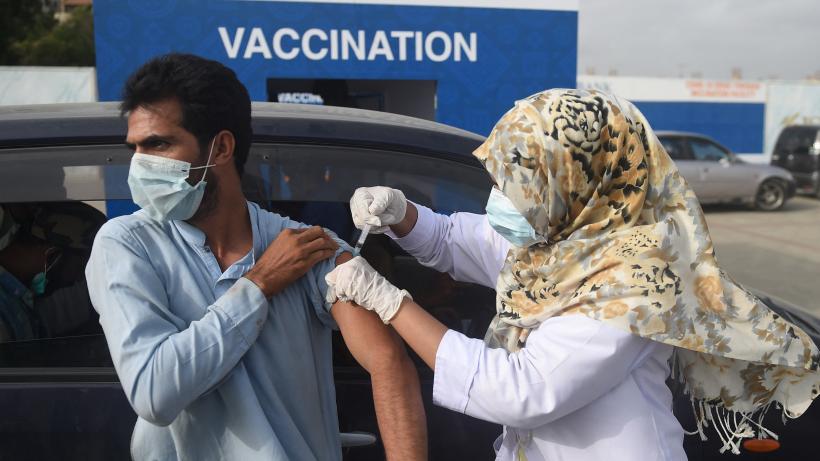
Cost-effective tools to incentivise vaccination: Evidence from lotteries in Pakistan
Compared to vaccine mandates or safety-related messages, a lottery-based financial incentive was most effective at increasing willingness and uptake of COVID-19 boosters.
It is increasingly recognised that regular COVID-19 boosters will be necessary for the continued management of the COVID-19 pandemic, especially for those most at risk of severe COVID. Currently, COVID-19 booster uptake is believed to be low in most countries; many countries have still not achieved high rates of primary vaccinations.
Efforts to encourage booster uptake will face even steeper challenges than initial vaccination efforts, given the widespread perception that the threat from COVID-19 has subsided. Financial incentives have been found to be effective at promoting a variety of health behaviours and have also been explored as a means to increase vaccine uptake.
Lotteries could be an efficient way to incentivise vaccine uptake
Lotteries are one type of financial incentive that have been used to increase COVID-19 primary vaccination. A study on Ohio’s Vax-A-Million initiative found that the monetary incentive scheme led to an increase in the vaccination uptake in the state population. Similar results were found in a randomised controlled trial in Sweden, where monetary payments led to an increase in the vaccination rates.
Lotteries are also low cost. Rather than providing financial incentives to everyone to vaccinate, lotteries enable governments to set aside a smaller pot of money and leverage people’s tendencies to overestimate low-probability-but-high-reward events to induce desired behaviours efficiently. Previous studies have shown that lotteries with low probabilities of winning large prizes may be more effective than equivalent lotteries with somewhat higher probabilities of winning smaller prizes.
On the other hand, a study conducted in California found that small monetary incentives did not considerably increase vaccination rates. It is possible that this modest financial incentive was not enough to entice vaccination, especially in a higher income setting. By contrast, even modest lotteries may be effective in resource constrained settings where money goes further.
Comparing lotteries to vaccine mandates, quality- and side-effects-related concerns
While several studies have examined the use of lotteries in the US context towards incentivising primary vaccination, we focused on the effectiveness of vaccination in a medium-sized city in Pakistan.
To understand vaccine hesitancy and if behavioural interventions can lead to an increase in uptake of the COVID-19 booster vaccine, we conducted an experiment at a large, urban hospital. The study took place between 21 December 2022 and 25 January 2023, after Pakistan’s primary COVID-19 vaccination campaign had ended, but when COVID-19 was still fresh in people’s minds.
Patients were stopped on their way into the hospital by the study team, and were randomised to receive one of four different messages incentivising them to receive a vaccine or booster, depending on their eligibility, during their visit to the hospital:
- Vaccine mandates: The first message emphasised that boosters may be required for certain travel destinations, work and such to emphasise the inconvenience of not vaccinating.
- Side-effects minimisation: The second message focused on the safety of the vaccine/booster, and the fact that it only has minimal side-effects, to correct misperceptions that the vaccine side-effects may be worse than the disease.
- Vaccine quality: The third message informed patients that they could get Pfizer or Moderna versions of the booster, and not the earlier versions (Chinese or Russian vaccines, which were generally perceived as lower quality).
- Financial incentive: The fourth message or the lottery message emphasised that if participants agreed to get the booster, their name would be entered in a lottery for a chance to win PKR 30,000 (approximately US$ 110). (For perspective, the patients interviewed had an average monthly income of PKR 34,000 (about US$ 150).)
We also collected information about their previous vaccination, vaccine preferences, their demographics, and other characteristics. We then compared how likely each group was to say they were planning to get vaccinated that day to a control group, to whom we did not give any particular messages. We also looked at whether respondents actually got vaccinated following their visit, through a follow-up phone interview with individuals who gave their cell phone numbers.
Lotteries were the most effective at changing vaccination willingness and uptake
Of the 1,564 patients that were stopped on their way into the hospital, 90% had received the initial COVID-19 vaccine. However, virtually none (99.6% to be precise) reported having received a booster.
Of the four messages, the financial incentive (lottery) arm was the most effective: willingness to get vaccinated increased by 42 percentage points in the lottery message arm. By contrast, for individuals who received the vaccine mandates message, willingness to get vaccinated increased by 8 percentage points, while for the side-effects minimisation arm it increased by 6 percentage points. We found no effect for the message emphasising the quality of the vaccine, even though patients were being offered a much more effective vaccine.
In the follow-up survey, the likelihood that an individual got their booster subsequent to their hospital visit was 20 percentage points higher in the lottery message arm than the control (no message) condition.
While lotteries can incentivise vaccination, vaccine availability is also a concern
Lotteries may be a practical way to increase voluntary booster uptake when vaccines are also made easily and freely available to the public, when people are on their way to seeking routine medical care. Financial incentives may lead to increased vaccination uptake without limiting individuals’ freedom, as in the case with mandates, and may cultivate civic responsibility by rewarding good behaviour.
This is likely a cost-effective mechanism for many low- and middle-income countries to increase booster uptake, as we show that even a modest cash incentive increased uptake. However, the continued ability of countries to offer free vaccination through on-site vaccine clinics remains in question and may depend on global vaccine donation programmes.

